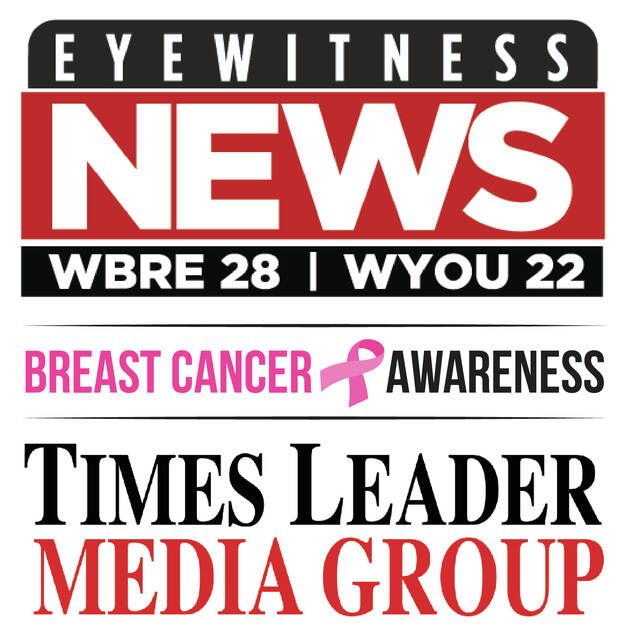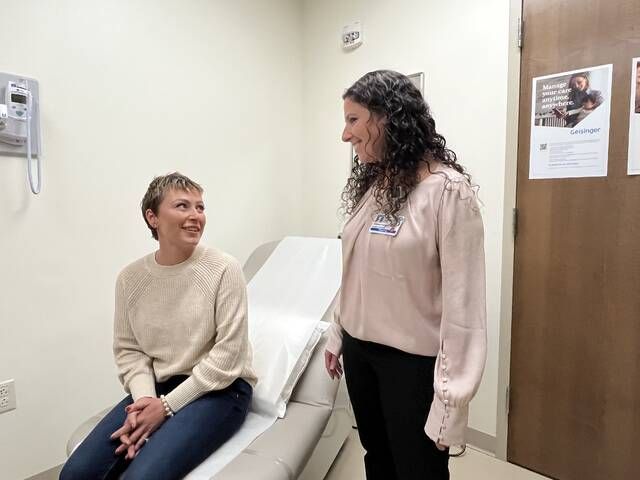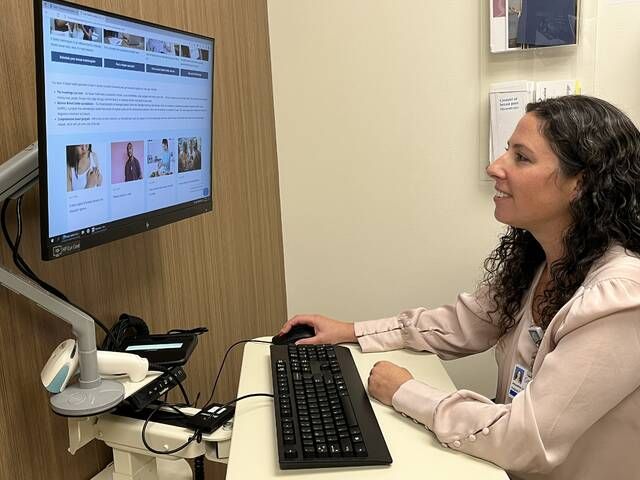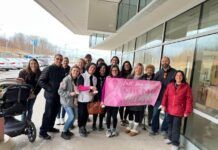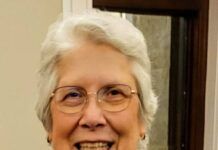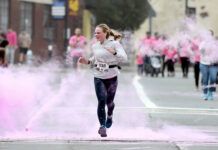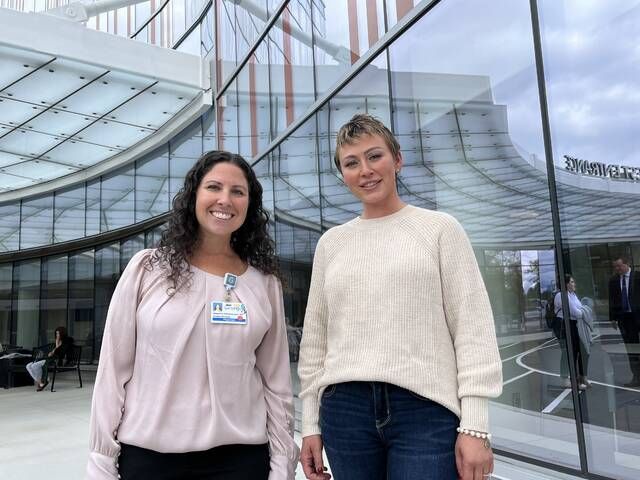
Geisinger cancer surgeon Dr. Jacqueline Oxenberg, left, and her patient, Monica Horvath, are seen outside Geisinger’s Frank M. and Dorothea Henry Cancer Center in Plains Township, one of the locations where Horvath was treated for breast cancer.
Roger DuPuis | Times Leader
Breast cancer patient, 34, talks about diagnosis, treatment
Click here to subscribe today or Login.
PLAINS TWP. — Monica Horvath did all the right things.
“I was very healthy. Very active. Always ate and followed a healthy diet, exercised. You know, very active, daily. Always went for a routine yearly physical,” she said.
Last August the Scranton resident made a startling discovery.
“I noticed a lump through my bathing suit and I was just like this is odd. You know, I’ve never noticed this before,” Horvath said. “At that point I was thinking it could be a cyst, you know, it could be anything. ‘You’re good, you’re young, you’re healthy, you take care of yourself.’”
What she found turned out to be stage 3 breast cancer.
The diagnosis made no sense to her. In fact, Horvath had undergone a physical just a month before she discovered the tumor, which doctors believe was growing inside her for a few years.
“Unfortunately, a routine blood work panel does not tell you if you have breast cancer,” Horvath explained.
What was also surprising? She was just 32 when she was diagnosed — on the day before her 33rd birthday.
“Breast cancer in your 30s is possible. It is not as common,” said Geisinger cancer surgeon Dr. Jacqueline Oxenberg, who treated Horvath.
October is national breast cancer awareness month. As a joint reporting project, the Times Leader and Eyewitness News are helping shed light on the importance of prevention, diagnosis, and treatment of breast cancer.
The American cancer society estimates nearly 289,000 new cases of invasive breast cancer will be diagnosed this year.
Horvath and Oxenberg met with reporters last week at Geisinger’s Frank M. and Dorothea Henry Cancer Center in Plains Township to talk about Horvath’s story, and to help encourage other women to be vigilant.
Tough battle, good news
It was good news for Horvath, 34, as she met with Oxenberg last week.
“No bumps? No lumps?” the doctor asked.
“No bumps. No lumps,” Horvath responded.
She has “technically” been in remission since May 4, but must still take oral chemo treatments through January.
Horvath’s cancerous tumor initially was too large for surgery.
“They said it started in the milk duct, so it was contained to the milk duct,” Horvath said. “So that’s why I wasn’t able to feel it until the tumor got so big that it broke through. And that’s when I was able to feel it.”
She underwent six months of chemotherapy to shrink the tumor sufficiently and allow Dr. Oxenberg the ability to remove it.
She underwent surgery in early May at Geisinger Wyoming Valley medical center. Even though the cancerous tumor was found in her left breast, she made the decision to have both breasts removed.
What followed was six weeks of radiation and a fighting spirit to meet cancer head-on.
“This was not going to be the end of my life. I knew that I was still going to keep pushing. I was going to keep fighting and I’m still here,” Horvath said.
“It’s scary. I mean, there was a good chance that I wasn’t going to be here,” she added.
The radiation was a harrowing experience.
“Radiation is tough,” Horvath said. “My radiation appointments were at 6:30 every morning. So every day it was like waking up for work, but I wasn’t going to work.”
The radiation left her tired, and suffering from “extensive radiation burns.”
“But luckily I’m all healed up now from that. And, you know, things are looking good and I’m really starting to feel like myself again,” she said.
Assessing the risks
Horvath also had only a minimal family history with the disease: Her maternal grandmother was diagnosed in her 70s, underwent a simple lumpectomy and three weeks of radiation, and lived to be 93 — with no recurrence.
“I have aunts, cousins, three sisters. No one else has been diagnosed besides me,” Horvath said.
She underwent genetic testing and learned that neither she, nor her parents, nor her sisters carry the gene.
Oxenberg also said Horvath also did not have the typical risk factors often associated with breast cancer like mutations to the BRCA1 or BRCA2 genes.
“We don’t know everything about genetics. While we’ve come a very, very long way we do know that genetics is not the only (factor), the known genetic mutations that we have right now are not the only thing that can put people at risk for breast cancer,” Oxenberg explained.
“She felt something. She got it addressed. It’s a treatable cancer. It’s a curable cancer, too. You know, so listening to your body and knowing your own risks and family risks, that’s really the message,” Oxenberg added.
Horvath has her own message for women everywhere about breast cancer.
“Those routine and monthly self-breast exams are really important and that’s actually what saved me,” Horvath stated.
‘I couldn’t let cancer stop me’
Horvath has a 10-year-old son and a 13-year-old daughter. Her teenage daughter will begin screenings for breast cancer when she is 22.
“And that’s really been my push to, you know, keep fighting to get through this,” Horvath said of her children. “They were my saving grace.”
Horvath described herself as a fighter, adding: “And that’s really been been my goal through this whole thing.”
“You know, a handful of people have reached out and just said, ‘How do you do this? How do you wake up every day? And how do you go on with a smile on your face? And, you know, you never missed your son’s basketball games, you’ve never missed your daughter’s track meets. Like, how do you go on with such a positive attitude,’” she said.
“And I don’t really have the answer for that, but that’s just the type of person that I am,” Horvath added.
“I couldn’t slow down. I couldn’t stop and I couldn’t let cancer stop me. And I didn’t.”
***
This is the first of a series of interviews with breast cancer patients and survivors we will be publishing for Breast Cancer Awareness Month, in conjunction with our news partners at Eyewitness News WBRE/WYOU. Watch for more stories in the paper on Oct. 5 and 6, and on our website at www.timesleader.com/breastcancerawareness.





